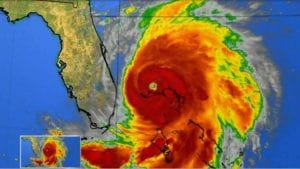New Study Shows Possible Improvement In Rapid Intensification Predictions
FORT LAUDERDALE/DAVIE, Fla. – Rapid intensification is a serious challenge for the prediction of hurricane intensity. An example is Hurricane Maria in 2017, which intensified to a Category 5 storm within 24 hours and destroyed Puerto Rico. None of the computer models were able to predict it. A more recent example is Hurricane Dorian, which was predicted to become just a tropical storm, before it rapidly intensified into a Category 5 storm and caused extensive damage in the Bahamas.
 An Index to Better Estimate Tropical Cyclone Intensity Change in the Western North Pacific, published in the September 2019 issue of American Geophysical Union’s journal Geophysical Research Letters, includes a new operational algorithm that improves prediction of the rapid intensification that may occur in tropical cyclones within 24 hours. The paper is a collaborative effort between researchers from the United States and the Republic of Korea.
An Index to Better Estimate Tropical Cyclone Intensity Change in the Western North Pacific, published in the September 2019 issue of American Geophysical Union’s journal Geophysical Research Letters, includes a new operational algorithm that improves prediction of the rapid intensification that may occur in tropical cyclones within 24 hours. The paper is a collaborative effort between researchers from the United States and the Republic of Korea.
Alexander Soloviev, Ph.D., a professor and research scientist at Nova Southeastern University’s (NSU) Halmos College of Natural Sciences and Oceanography who co-authored the paper, said the new algorithm may be a game changer in the field of hurricane intensity prediction. This new index is expected to contribute to improvements in real‐time intensity forecasts, not only for the western North Pacific but also for other basins including Florida, the North Atlantic and the Gulf of Mexico.
“We have taken into account the phenomenon of the ‘slippery sea surface’ under certain hurricane conditions, which is conducive to rapid storm intensification,” he said.
These results were previously published in the Nature Scientific Reports and the Journal of Geophysical Research and implemented in the new operational index for rapid intensification, which reduced the error of tropical cyclone prediction within 24 hour period by 16%.
“The objective of this study is to improve intensity prediction, especially in a short temporal range of 24 hours,” said Woojeong Lee, Ph.D., from the National Typhoon Center, Jeju, the Republic of Korea, who is the first author of this paper. “We developed a synoptic predictor for intensity change based on the microphysics study of the air-sea interface in hurricane conditions conducted by U.S. scientists from NSU, the University of Miami, the University of Hawaii and the University of Rhode Island.”
While track prediction of tropical cyclones (TCs) has improved steadily over the last three decades, there has been comparatively little advancement in intensity prediction due to the complicated physical mechanisms involved in internal TC dynamics and their interaction with upper ocean and atmospheric circulation.
Be sure to sign up for NSU’s RSS feed so you don’t miss any of our news releases, guest editorials and other announcements. Please sign up HERE.
###
About Nova Southeastern University (NSU): At NSU, students don’t just get an education, they get the competitive edge they need for real careers, real contributions and real life. A dynamic, private research university, NSU is providing high-quality educational and research programs at the undergraduate, graduate, and professional degree levels. Established in 1964, the university includes 16 colleges, the 215,000-square-foot Center for Collaborative Research, a private JK-12 grade school, the Mailman Segal Center (early childhood education) with specialists in Autism, the world-class NSU Art Museum Fort Lauderdale, and the Alvin Sherman Library, Research and Information Technology Center, one of Florida’s largest public libraries. NSU students learn at our campuses in Fort Lauderdale, Fort Myers, Jacksonville, Miami, Miramar, Orlando, Palm Beach, and Tampa, Florida, as well as San Juan, Puerto Rico, and online globally. Classified as having “high research activity” by the Carnegie Foundation for the Advancement of Teaching, NSU is one of only 50 universities nationwide to also be awarded Carnegie’s Community Engagement Classification, and is also the largest private institution in the United States that meets the U.S. Department of Education’s criteria as a Hispanic-serving Institution. Please visit www.nova.edu for more information.
About NSU’s Halmos College of Natural Sciences and Oceanography: The college provides high-quality undergraduate (bachelor’s degree) and graduate (master’s and doctoral degrees and certificates) education programs in a broad range of disciplines, including marine sciences, mathematics, biophysics, and chemistry. Researchers carry out innovative basic and applied research programs in coral reef biology, ecology, and geology; fish biology, ecology, and conservation; shark and billfish ecology; fisheries science; deep-sea organismal biology and ecology; invertebrate and vertebrate genomics, genetics, molecular ecology, and evolution; microbiology; biodiversity; observation and modeling of large-scale ocean circulation, coastal dynamics, and ocean atmosphere coupling; benthic habitat mapping; biodiversity; histology; and calcification. The college’s newest building is the state-of-the-art Guy Harvey Oceanographic Center, an 86,000-square-foot structure filled with laboratories; offices; seminar rooms; an auditorium; and indoor and outdoor running sea water facilities. Please visit cnso.nova.edu for more information.
MEDIA CONTACT
Joe Donzelli | Office of Media Relations
Nova Southeastern University
954-262-2159 (office) | 954-661-4571 (cell)
jdonzelli@nova.edu | www.nova.edu | @NSU_Joe